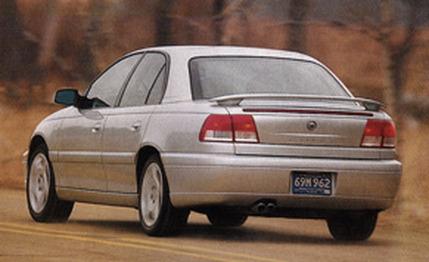
 Road Test
Road Test
When the Catera first appeared in 1996, members of the press -- uh, possibly even us -- just about ruptured themselves recalling tales of the company's previous "entry level" Cadillac. That analogy, we're eager to report, was silly. Whereas the Cimarron was based on a Chevy Cavalier -- a piece of machinery more effective in its original ore state -- the Catera emerged as a lightly made-over Opel Omega V-6 whose metamorphosis to U.S.-legal trim diminished its celebrated competence only marginally.
For 2000, the Catera's nose and tail are more gracefully sculpted -- an earnest if modest attempt -- and the car benefits from new side-view mirrors, HID headlamps, reshaped inner door panels, and front side airbags. The $2000 "Sport" package, as tested here, includes a decklid spoiler, a stiffer suspension, more aggressively bolstered front seats, 17-inch alloy wheels -- macho five-spokers from the AMG "monoblock" school of design -- and faux-brushed-aluminum trim surrounding the instrument panel, center stack, and shifter. That trim might actually be appealing if it were some material other than plastic.
The Catera's interior, historically a funereal study in gray and black, remains somber but not quite dour. Let's call it businesslike, maybe "densely Teutonic." The Sport's front seats reinforce the effect. They're as unyielding as park benches, as firm as any leather-encased appurtenance yet devised by BMW. Like the best of the German interiors, though, almost every surface here feels substantial, appropriately upscale, satisfyingly rendered. Check out the damped, fluid action of the fold-down armrest, for instance, or the sunroof cover that glides into place with a heartening ka-thunk.
More important, the Catera's platform, even when slammed relentlessly over Michigan's frost-heaved roads, is reliably rigid, flex-free, and disinclined to bottom out or transmit much by way of road noise. Combine that with a cockpit already devoid of rattles, and the Catera becomes a remarkably Benz-like perch from which to negotiate America's byways.
This year, a calibration change to the brake booster has resulted in a firmer, more confident pedal. We definitely noticed. The Bosch ABS manages to halt this sedan from 70 mph in 177 feet, a notable achievement. The Catera's steering -- recalibrated to improve on-center feel -- is direct, linear, and predictable, with confident tracking and a firm sense of straight-ahead. Its effort, though, is on the high side, which adds to the sensation that this car is heavy.
And you know what? That's not just a sensation. The Catera is 388 pounds beefier than the average heft of the nine $28,000-to-$32,000 sedans tested in our "Ennui and Upward!" comparison last February. Attach that much bulk to an engine producing only 200 horsepower -- an output surpassed by every V-6 in the aforementioned comparo -- and you wind up with 0-to-60 and quarter-mile sprints that are 0.3 second slower than the averages of those nine sedans. Like a fat guy climbing steps, the Catera often feels out of breath.
Making up for some of that sluggishness are the Sport's tauter springs (25 percent stiffer fore, 10 percent stiffer aft) and revised damping (30 percent firmer in rebound in front, 20 percent firmer in the rear; plus 100 percent firmer in compression both front and rear). Pushed hard in turns, the Sport is a paradigm of German stateliness: calm, controlled, and confident, even when hustled at felonious speeds around our 10Best handling loop. Body roll is negligible, and the car turns in smartly and then tracks through the corner in a tight, crisp trajectory requiring few corrections. Among the last five Cateras we've tested, skidpad grip has averaged 0.77 g; the Sport raises the bar to 0.82 g.
It helps, too, that the Catera's hood disappears almost entirely from the driver's line of sight. Apexes hove clearly into panoramic view, and throughout all this spirited thrusting, the steering keeps muttering, "Hey, let's go a little faster."